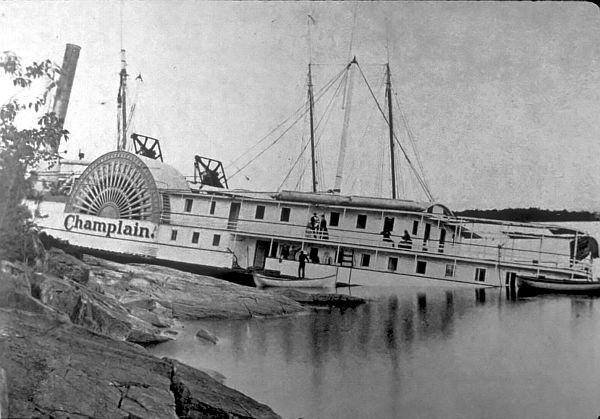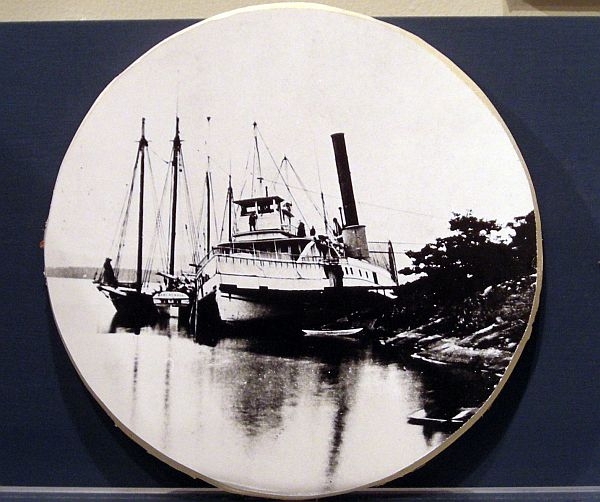 (HOST) All this week VPR is looking at five of the many shipwrecks that lie at the bottom of Lake Champlain in our series "History Under the Waves." Today we hear about The Champlain II. It was nearly a football field in length and entirely made of wood. Built in 1868 and originally named the Oakes Ames, it was designed to carry railroad cars across Lake Champlain.
(HOST) All this week VPR is looking at five of the many shipwrecks that lie at the bottom of Lake Champlain in our series "History Under the Waves." Today we hear about The Champlain II. It was nearly a football field in length and entirely made of wood. Built in 1868 and originally named the Oakes Ames, it was designed to carry railroad cars across Lake Champlain.
But it had two careers. In 1874 the Champlain Transportation Company bought the boat and transformed it into the most opulent, well appointed luxury passenger steamboat on Lake Champlain. It was renamed the Champlain II.
Click here for the History Under the Waves photo gallery
On July 16th 1875 the boat left Whitehall, New York, working it’s way north on the lake. It reached Westport New York at 11pm. Adam Kane, archeologist and Project Manager with the Lake Champlain Maritime Museum picks up the story. 
(KANE) At Westport they switched pilots. The pilot that had been in charge was a pilot, L. Rockwell. He changes shifts and a pilot by the name of John Eldridge takes over the helm. And he takes the boat out of the dock at Westport and starts steaming north.
As pilot Rockwell settled himself into bed as soon as he had fallen asleep, the boat was jarred by this massive, grinding, ripping, boat destroying sound, everything lurching. Rockwell rushes into the pilot house and he sees John Eldridge still at the helm. Eldridge turns to Rockwell and asks him "Can you please account for my being on the mountain?"

And Rockwell looks out to see that literally they are on the side of Split Rock Mountain. There are trees…tree branches near the pilot house of the boat.
The stern of the boat starts to flood. There are about fifty people on board and it starts to sink down by the stern. Captain Rushlow, the captain of the steamer immediately gets everybody out of bed, onto the deck and loads everybody onto the shoreline to make sure that nobody is injured. And everybody manages to get out with only a few bumps and bruises.
And over the course of the coming days, as much as could possibly be taken out of the steamboat was salvaged. All the wood – everything that could taken off of it – even the pilot house was taken and recycled into buildings all around this part of Lake Champlain. There are still buildings over in Westport that are made from timbers from the Champlain.
There was an inquest. It was found that the pilot was known along the pharmacies along Lake Champlain for buying opium, for buying laudanum. And he had over the course of the proceeding weeks stopped at different pharmacies sometimes multiple times to buy opium to relieve pains that he was having.
So although he was never convicted in a criminal court, he was certainly convicted in the court of public opinion for being in an opium-induced stupor as he ran the boat aground in a run that should have been second nature for him.

When winter came, the lake froze. The hulk was frozen into the lake, and as the ice went out, it dragged the wreck around. It actually turned it one hundred and eighty degrees so that the part that was up on the rocks got turned into the deeper part of the lake and that part in the lake where you can see the massive damage from it running aground, the staves, the frames that are broken, is in about thirty-five feet of water, and then the shallower part of the wreck, the stern post, is in about fifteen feet of water.
The dive is shallow. You descend down the line into…down to the mooring block. Once you get to the mooring block it’s about twenty feet to the boat. You can see the shadow in the distance of this very large form off in the distance. As you swim the guideline towards the boat, you see this really massive structure take shape underwater.
The stern post is still standing on the boat and as you swim it, you’re struck by how massive the boat is.
When you have the opportunity to dive on a wreck and understand it for the first time, to have a chance to look at a wreck that nobody else knows about and to be able to figure out what this shipwreck is and then take that information and share it with the public and be able to present – we found this new shipwreck on Lake Champlain, and you’re finding and revealing new knowledge to the public. And for me that’s very satisfying.
(HOST) Tomorrow in our final episode of History Under the Waves, we look at the sailing canal boat General Butler and its dramatic end on a cold December night at the Burlington Breakwater. You can find more information on this series and others in our Champlain400 coverage at VPR.net.
Originally broadcast July 30, 2009 as part of VPR’s Champlain 400 coverage.